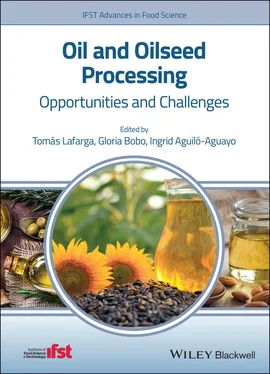Only a small amount of the maize currently cultivated is used for oil production. Total maize oil production during 2014 was 3.18 Mt, led by the US, China, Turkey, and Brazil with oil production quantities of 1.82, 0.26, 0.19, and 0.09 Mt. Major oil exporters during 2016 were the US, Turkey, and Spain with approximately 0.47, 0.05, and 0.04 Mt of oil exported. Spain was also one of the largest importers, with 0.09 Mt, only surpassed by Libya, who imported 0.10 Mt of maize oil during 2016. Overall, although human consumption of maize has remained steady over the last years, its global production has slightly but steadily increased mainly caused by an increase in its use for animal feed and for biofuel production.
The olive tree ( Olea europea L.) is one of the oldest known cultivated trees in the world and olive oil has become one of the most widely accepted and used oils in culinary applications. The amount of food products manufactured using olive oil increases every year. Some of these are listed in Table 1.1. Olive oil is a staple food for people living in Mediterranean countries but its use is now expanding to other parts of the world. As can be seen in Figure 1.1, the olive tree is currently being cultivated in several countries including Spain, Italy, Greece, Tunisia, Portugal, Turkey, Morocco, Argentina, Australia, and the US, among others. The world production of olives was approximately 20.87 Mt in 2017. Approximately 62% of the total world production of olives was carried out in Europe, with Spain, Greece, and Italy the biggest producers with 6.54, 2.72, and 2.57 Mt/year in 2017, respectively. The EU is the leading producer, consumer, and exporter of olive oil: indeed, in the last five marketing years the EU produced, consumed, and exported 67, 55, and 67% of the worlds' olive oil. The biggest non‐European producers were Morocco and Egypt with an annual production of 1.03 and 0.92 Mt in 2017 (UN 2019). Major exporters of olive fruit in 2016 were Portugal, Spain, Mexico, Greece, and Jordan: 24.69, 12.81, 10.72, 4.47, and 3.39 kt, respectively. Portugal was also the most important importer of olives, with approximately 19.25 kt imported during 2016, most of these from Spain (EU 2019). Spain is the biggest producer of olive oil followed by Italy and Greece with a production of 1.73, 0.29, and 0.21 Mt of virgin olive oil during 2014, respectively. These countries were also the most important exporters with approximately 920.82, 354.29, and 161.00 kt exported during 2016. Major non‐European olive oil producers are Tunisia and Morocco, followed by Syria with an annual production of approximately 179.70, 137.40, and 100.64 kt, respectively. Tunisia ranks fifth just behind Portugal among the major olive oil exporters with 107.95 and 117.83 kt of oil exported in 2016. During 2018/2019, from the total 124.06 kt of olive oil exported from the EU to non‐EU countries, 41.80, 12.80, 9.66, and 5.74 kt were imported by the US, China, Japan, and Canada, respectively (Ferraris 2019). These values show a 22.6, 0.5, 18.4, and 34.4% increase when compared to the period 2017/2018.
1.2.7 Palm and Palm Kernel Oil
The oil palm fruit, which is obtained from the palm tree ( Elaeis guineensis L.), is a drupe formed in tight bunches. Palm fruit is mainly used for the extraction of palm oil driven by a lower price, and the fact that one hectare of oil palm plantation can produce up to 10 more times oil than other leading oilseed crops (Mba et al. 2015). Palm oil can be divided into crude palm oil, obtained from the fruits mesocarp, and palm kernel oil. Both are key important in world trade. Indeed, palm oil was the fourth most produced commodity within the “processed crops” classification of FAOSTAT, surpassed only by beer of barley, sugar, and molasses. Palm oil production has boomed over the last decades caused by an increasing use as frying oil, as an ingredient in foods and other products such as detergents, and biodiesel production (Pirker et al. 2016). As shown in Figure 1.2, total world production of palm oil increased from 45.78 Mt in the year 2000 to 57.33 Mt in 2014. In 2019, the total world production of palm oil has been calculated as 70.90 Mt, representing a 16.16% annual increase during the last decade.
Malaysia and Indonesia have been the center of this impressive increase. As an example, planted areas increased from 3.37 and 2.01 Mha in 2000 to 5.11 and 9.28 Mha in 2017, which represent an averaged 8.90 and 27.09% annual increase during the period 2000–2017 in Malaysia and Indonesia, respectively. The USDA recently forecasted the Indonesian oil palm harvested area for 2018/2019 as 11.3 Mha. In 2016, Vijay et al. (2016) assessed the impact of oil palm on deforestation and biodiversity loss and reported that 45% of sampled oil palm plantations evaluated in Southern Asia came from areas that were forests in 1989 (less than three decades). Similar conclusions were obtained by Henders et al. (2015), who observed that over 50% of Malaysian and Indonesian oil palm plantations in 2005 were on land that was forest in the 1990s. This has led not only to obvious negative environmental issues, but also to closer scrutiny from consumers. However, as global demand for food increases and land availability in those countries becomes scarcer, governments of developing and emerging countries such as Brazil, Peru, and some African countries are increasingly promoting palm tree cultivation (Pirker et al. 2016). Nowadays, the palm tree is cultivated in several countries with adequate temperature, sunlight, and rainfall ( Figure 1.1). However, major palm oil producers continue to be Indonesia, Malaysia, and Thailand with an annual productions in 2017 of approximately 29.27, 19.67, and 1.85 Mt. As shown in Figure 1.3, Malaysia and Indonesia are also the largest palm oil exporters with approximately 22.76 and 13.81 Mt exported during 2017.

Figure 1.2 Area harvested and production of palm, rapeseed, soybean, and sunflower seed oil.
Source: Data accessed on April 8, 2019 from FAOSTAT, available at http://www.fao.org/faostat.
Major palm oil importers in 2017 were India, China, and Pakistan with 8.26, 4.48, and 2.60 Mt respectively.

Figure 1.3 Palm oil: Production and trade. Abbreviation: PNG, Papua New Guinea.
Source: Data accessed on April 8, 2019 from FAOSTAT, available at http://www.fao.org/faostat.
1.2.8 Rapeseed and Canola Oil
The genus Brassica , which is the most important within the Brassicaceae family, includes the six interrelated species Brassica nigra , Brassica oleracea , Brassica rapa , Brassica carinata , Brassica juncea , and Brassica napus (Cartea et al. 2016). Both rapeseed and canola belong to the Brassicaceae family. In some countries, the term rapeseed oil refers to the oils for industrial use, while canola oil is used to refer to the edible cooking oil. Canola is a subgroup within the rapeseeds and include those Brassica species having seeds containing oil with under 2% erucic acid and low levels of glucosinolates. As an estimate, Daun (2015) recently suggested that, to identify the amount of rapeseed crops that are canola quality, a good estimate can be obtained by assuming that all production in North America, Australia, Scandinavia, and Western Europe is canola quality, while only 10 and 75% of the production in China and Eastern Europe are canola. In the current chapter, all Brassica seeds utilized for oil production will be referred to as rapeseeds. Currently, rapeseeds rank second in world production of oilseeds (third if considering palm oil). According to data accessed from the USDA, world production of rapeseed during 2018/2019 was 70.37 Mt (USDA 2019a). Production of rapeseed in the EU increased from 19.02 Mt in 2009 to 19.80 Mt in 2018, with a historical maximum production of 24.26 Mt in 2014 (European Commission 2019). Rapeseed has a long history of use in Europe, Scandinavia, China, and India and has been more recently introduced into Canada and Australia (Daun 2015). Rapeseeds are adapted to the cool extremes of the temperature zones: although the optimum growth temperature is around 10 °C, minimum temperatures for growth have been reported to be near 0 °C (Daun 2015). Major rapeseed growing areas, shown in Figure 1.1, include temperate areas of Europe, Asia, and to a lesser extent, North America. Indeed, 41.5 and 39.3% of the total rapeseed oil production was carried out in Europe and Asia, respectively ( Figure 1.4). Rapeseed oil was ninth most produced commodity within the “processed crops” classification of FAOSTAT, and the third most produced oil only surpassed by palm oil and soybean oil, which ranked fourth and sixth, respectively.
Читать дальше














